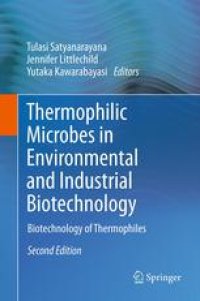
Ebook: Thermophilic Microbes in Environmental and Industrial Biotechnology: Biotechnology of Thermophiles
- Genre: Biology // Microbiology
- Tags: Biomedicine general, Applied Microbiology, Entomology, Bacteriology, Eukaryotic Microbiology, Waste Management/Waste Technology
- Year: 2013
- Publisher: Springer Netherlands
- Edition: 2
- Language: English
- pdf
The existence of life at high temperatures is quiet fascinating. At elevated temperatures, only microorganisms are capable of growth and survival. Many thermophilic microbial genera have been isolated from man-made (washing machines, factory effluents, waste streams and acid mine effluents) and natural (volcanic areas, geothermal areas, terrestrial hot springs, submarine hydrothermal vents, geothermally heated oil reserves and oil wells, sun-heated litter and soils/sediments) thermal habitats throughout the world. Both culture-dependent and culture-independent approaches have been employed for understanding the diversity of microbes in hot environments. Interest in their diversity, ecology, and physiology has increasedenormously during the past few decades as indicated by the deliberations in international conferences on extremophiles and thermophiles held every alternate year and papers published in journals such as Extremophiles. Thermophilic moulds and bacteria have been extensively studied in plant biomass bioconversion processes as sources of industrial enzymes and as gene donors. In the development of third generation biofuels such as bioethanol, thermophilic fungal and bacterial enzymes are of particular interest. The book is aimed at bringing together scattered up-to-date information on various aspects of thermophiles such as the diversity of thermophiles and viruses of thermophiles, their potential roles in pollution control and bioremediation, and composting.
The existence of life at high temperatures is quiet fascinating. At elevated temperatures, only microorganisms are capable of growth and survival. Many thermophilic microbial genera have been isolated from man-made (washing machines, factory effluents, waste streams and acid mine effluents) and natural (volcanic areas, geothermal areas, terrestrial hot springs, submarine hydrothermal vents, geothermally heated oil reserves and oil wells, sun-heated litter and soils/sediments) thermal habitats throughout the world. Both culture-dependent and culture-independent approaches have been employed for understanding the diversity of microbes in hot environments. Interest in their diversity, ecology, and physiology has increasedenormously during the past few decades as indicated by the deliberations in international conferences on extremophiles and thermophiles held every alternate year and papers published in journals such as Extremophiles.
Thermophilic moulds and bacteria have been extensively studied in plant biomass bioconversion processes as sources of industrial enzymes and as gene donors. In the development of third generation biofuels such as bioethanol, thermophilic fungal and bacterial enzymes are of particular interest. The book is aimed at bringing together scattered up-to-date information on various aspects of thermophiles such as the diversity of thermophiles and viruses of thermophiles, their potential roles in pollution control and bioremediation, and composting.
The existence of life at high temperatures is quiet fascinating. At elevated temperatures, only microorganisms are capable of growth and survival. Many thermophilic microbial genera have been isolated from man-made (washing machines, factory effluents, waste streams and acid mine effluents) and natural (volcanic areas, geothermal areas, terrestrial hot springs, submarine hydrothermal vents, geothermally heated oil reserves and oil wells, sun-heated litter and soils/sediments) thermal habitats throughout the world. Both culture-dependent and culture-independent approaches have been employed for understanding the diversity of microbes in hot environments. Interest in their diversity, ecology, and physiology has increasedenormously during the past few decades as indicated by the deliberations in international conferences on extremophiles and thermophiles held every alternate year and papers published in journals such as Extremophiles.
Thermophilic moulds and bacteria have been extensively studied in plant biomass bioconversion processes as sources of industrial enzymes and as gene donors. In the development of third generation biofuels such as bioethanol, thermophilic fungal and bacterial enzymes are of particular interest. The book is aimed at bringing together scattered up-to-date information on various aspects of thermophiles such as the diversity of thermophiles and viruses of thermophiles, their potential roles in pollution control and bioremediation, and composting.
Content:
Front Matter....Pages i-xx
Front Matter....Pages 1-1
Diversity of Hot Environments and Thermophilic Microbes....Pages 3-60
Exploring the Ecology of Thermophiles from Australia’s Great Artesian Basin During the Genomic Era....Pages 61-97
Hot Environments from Antarctica: Source of Thermophiles and Hyperthermophiles, with Potential Biotechnological Applications....Pages 99-118
Bacterial and Biochemical Properties of Newly Invented Aerobic, High-Temperature Compost....Pages 119-135
Role of Thermophilic Microflora in Composting....Pages 137-169
Metal Bioremediation by Thermophilic Microorganisms....Pages 171-201
CO-Oxidizing Anaerobic Thermophilic Prokaryotes....Pages 203-231
Biomineralization in Geothermal Environments....Pages 233-247
Phylogeny and Biological Features of Thermophiles....Pages 249-270
Biology, Biodiversity and Application of Thermophilic Viruses....Pages 271-304
Front Matter....Pages 305-305
Genomics of Thermophilic Bacteria and Archaea....Pages 307-330
Comparative Genomics of Thermophilic Bacteria and Archaea....Pages 331-349
Host-Vector Systems in Thermophiles....Pages 351-373
Molecular Chaperones in Thermophilic Eubacteria and Archaea....Pages 375-394
Heterologous Production of Thermostable Proteins and Enzymes....Pages 395-412
Discovery of Thermostable Enzymes from Hot Environmental Samples by Metagenomic Approaches....Pages 413-427
DNA Polymerases and DNA Ligases....Pages 429-457
Molecular Diversity and Biotechnological Relevance of Thermophilic Actinobacteria....Pages 459-479
Mechanisms of Thermal Stability Adopted by Thermophilic Proteins and Their Use in White Biotechnology....Pages 481-507
Starch-Hydrolyzing Enzymes from Thermophiles....Pages 509-533
Front Matter....Pages 305-305
Thermostable Archaeal and Bacterial Pullulanases and Amylopullulanases....Pages 535-587
Sugar Metabolic Enzymes....Pages 589-610
Restriction Enzymes from Thermophiles....Pages 611-647
Microbial Chitinases: Natural Sources, Mutagenesis, and Directed Evolution to Obtain Thermophilic Counterparts....Pages 649-669
Phytases and Phosphatases of Thermophilic Microbes: Production, Characteristics and Multifarious Biotechnological Applications....Pages 671-687
Pectinases of Thermophilic Microbes....Pages 689-710
Developments in Thermostable Gellan Lyase....Pages 711-730
The Lignocellulolytic System of Thermophilic Fungi and Actinomycetes: Structure, Regulation, and Biotechnological Applications....Pages 731-769
Cellulases of Thermophilic Microbes....Pages 771-793
Thermostable Bacterial Xylanases....Pages 795-811
Thermostable Proteases....Pages 813-857
Microbial Keratinases: Diversity and Applications....Pages 859-880
Biocatalysis Through Thermostable Lipases: Adding Flavor to Chemistry....Pages 881-904
Back Matter....Pages 905-927
....Pages 929-954